Diploma of Nursing Assignment: MSD, Cardiovascular & Nursing Care Plan
VerifiedAdded on 2022/11/14
|33
|4755
|8
Homework Assignment
AI Summary
This nursing assignment comprehensively addresses various medical conditions and nursing care plans, providing detailed insights into Musculo-Skeletal Disorders (MSD), including fracture signs and symptoms, and definitions of related conditions like bursitis, carpal tunnel syndrome, and muscular dystrophy. It further explores cardiovascular disorders, defining and comparing indigestion, angina, and myocardial infarction, including their signs, symptoms, alleviating factors, and ECG findings. The assignment also covers chest tube management, detailing client positioning, observations, insertion site care, patency, exercise, and emergency procedures. Additionally, it delves into Supra-Pubic Catheter (SPC) discharge advice, cerebral palsy definitions, and nursing interventions for associated health issues. Renal nursing topics, including urinary alterations, reasons for increased glucose in urine, investigations, infectious disorders, incontinence categories, catheterization, dialysis, and parts of the urinary system, are also discussed. Furthermore, the assignment addresses stoma care, providing insights into possible complications and management strategies. It concludes with nursing assessments for various conditions and critical thinking scenarios, along with a discussion of nervous system disorders and eye conditions. The assignment provides a holistic overview of nursing practices across various medical specialities.
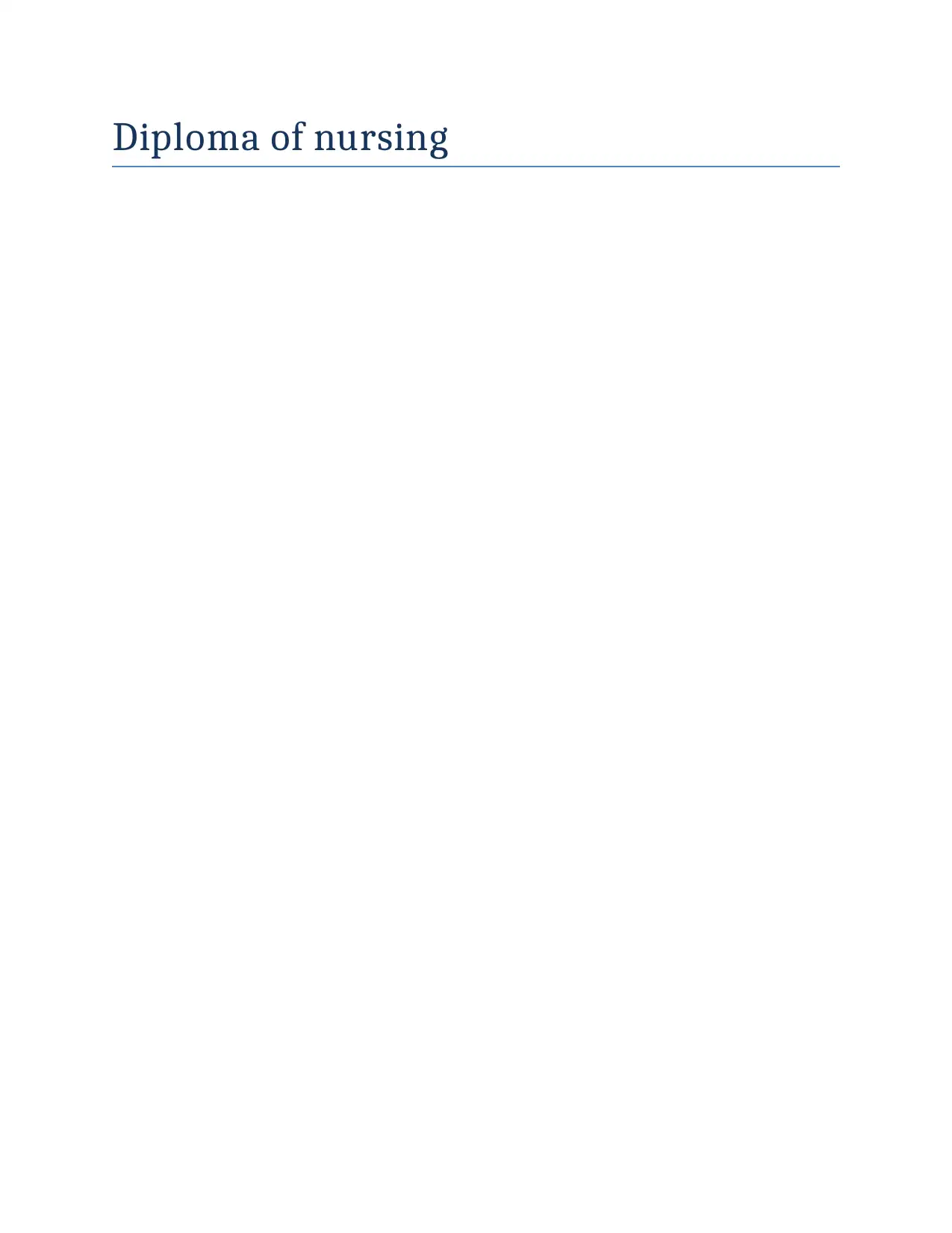
Diploma of nursing
Paraphrase This Document
Need a fresh take? Get an instant paraphrase of this document with our AI Paraphraser
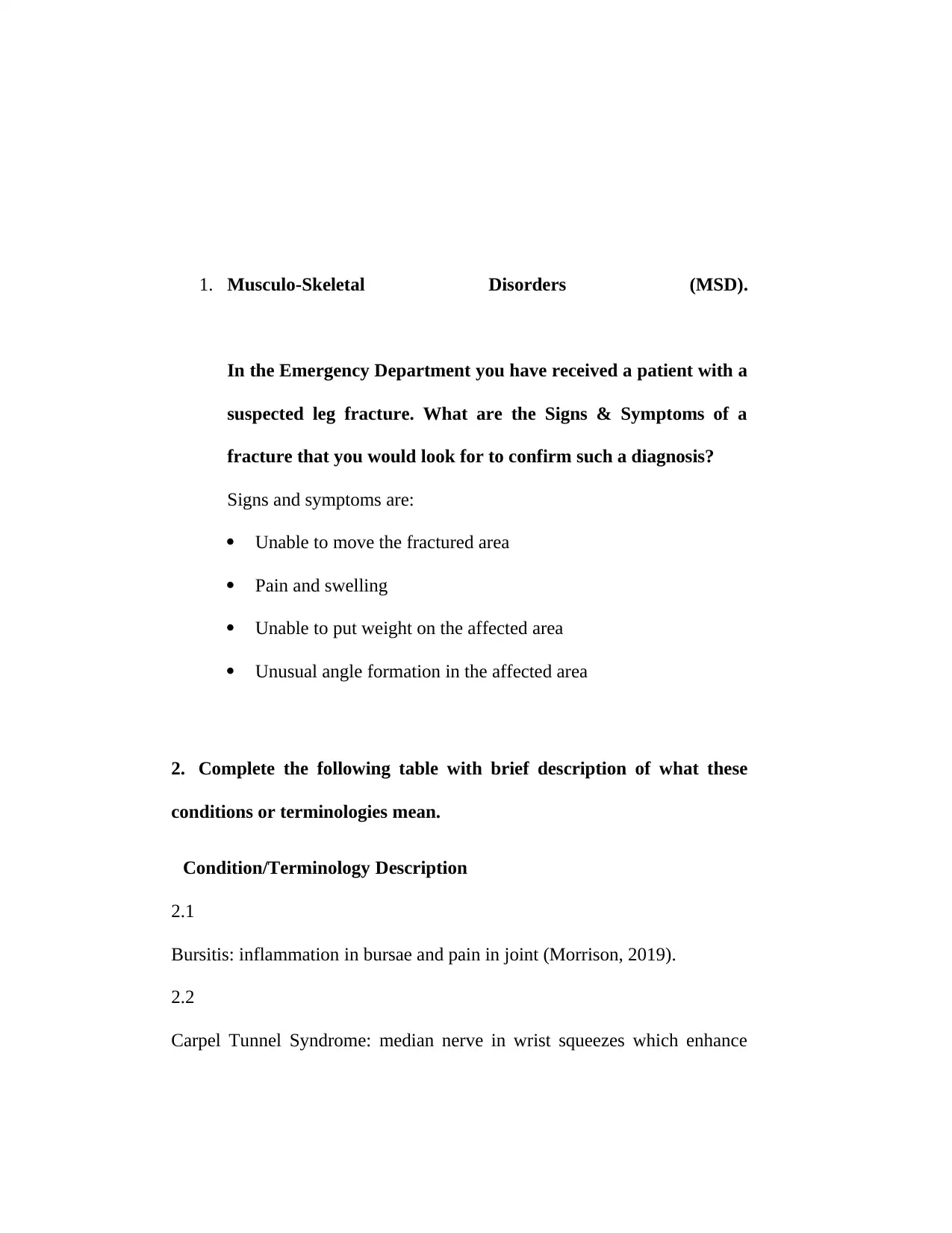
1. Musculo-Skeletal Disorders (MSD).
In the Emergency Department you have received a patient with a
suspected leg fracture. What are the Signs & Symptoms of a
fracture that you would look for to confirm such a diagnosis?
Signs and symptoms are:
Unable to move the fractured area
Pain and swelling
Unable to put weight on the affected area
Unusual angle formation in the affected area
2. Complete the following table with brief description of what these
conditions or terminologies mean.
Condition/Terminology Description
2.1
Bursitis: inflammation in bursae and pain in joint (Morrison, 2019).
2.2
Carpel Tunnel Syndrome: median nerve in wrist squeezes which enhance
In the Emergency Department you have received a patient with a
suspected leg fracture. What are the Signs & Symptoms of a
fracture that you would look for to confirm such a diagnosis?
Signs and symptoms are:
Unable to move the fractured area
Pain and swelling
Unable to put weight on the affected area
Unusual angle formation in the affected area
2. Complete the following table with brief description of what these
conditions or terminologies mean.
Condition/Terminology Description
2.1
Bursitis: inflammation in bursae and pain in joint (Morrison, 2019).
2.2
Carpel Tunnel Syndrome: median nerve in wrist squeezes which enhance
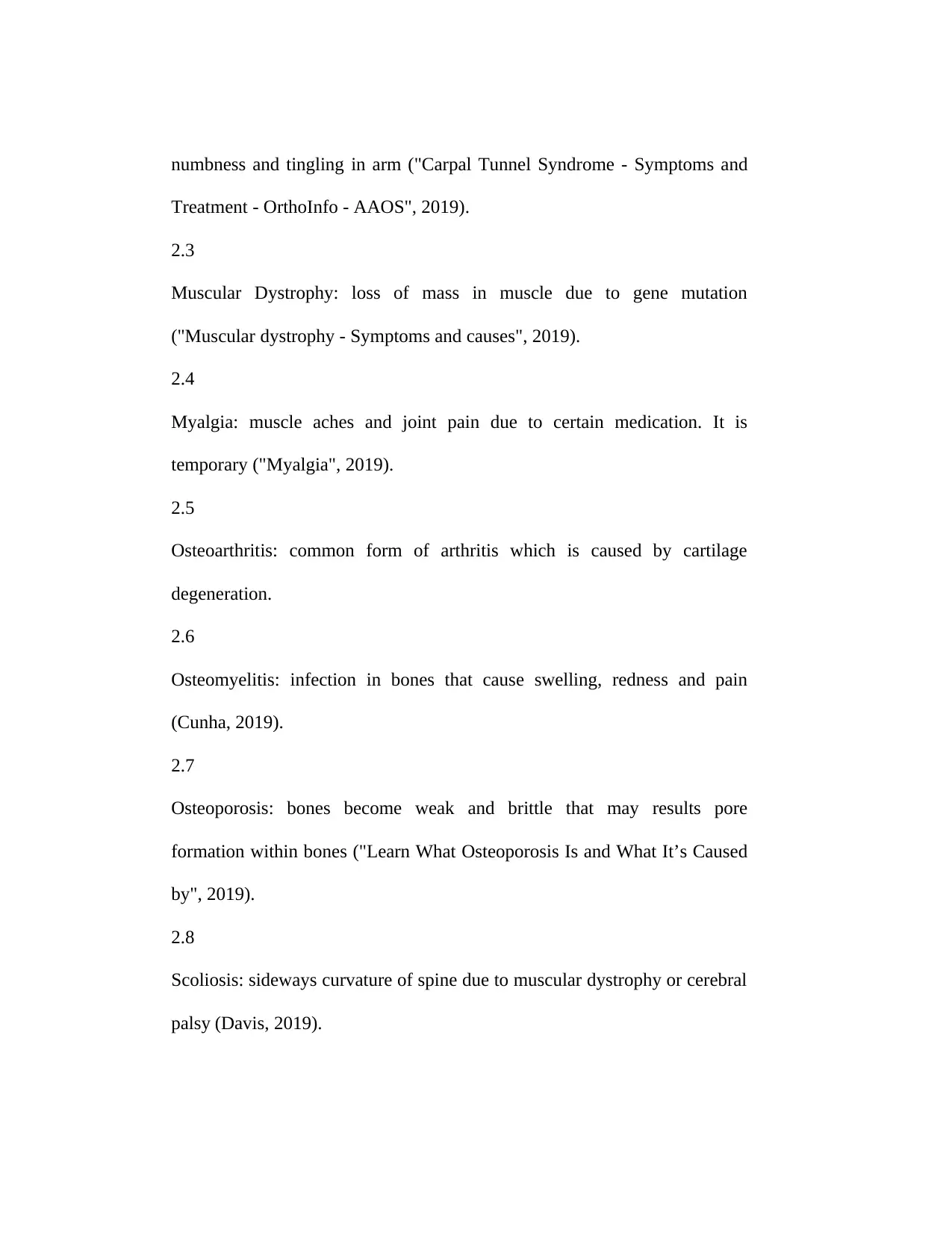
numbness and tingling in arm ("Carpal Tunnel Syndrome - Symptoms and
Treatment - OrthoInfo - AAOS", 2019).
2.3
Muscular Dystrophy: loss of mass in muscle due to gene mutation
("Muscular dystrophy - Symptoms and causes", 2019).
2.4
Myalgia: muscle aches and joint pain due to certain medication. It is
temporary ("Myalgia", 2019).
2.5
Osteoarthritis: common form of arthritis which is caused by cartilage
degeneration.
2.6
Osteomyelitis: infection in bones that cause swelling, redness and pain
(Cunha, 2019).
2.7
Osteoporosis: bones become weak and brittle that may results pore
formation within bones ("Learn What Osteoporosis Is and What It’s Caused
by", 2019).
2.8
Scoliosis: sideways curvature of spine due to muscular dystrophy or cerebral
palsy (Davis, 2019).
Treatment - OrthoInfo - AAOS", 2019).
2.3
Muscular Dystrophy: loss of mass in muscle due to gene mutation
("Muscular dystrophy - Symptoms and causes", 2019).
2.4
Myalgia: muscle aches and joint pain due to certain medication. It is
temporary ("Myalgia", 2019).
2.5
Osteoarthritis: common form of arthritis which is caused by cartilage
degeneration.
2.6
Osteomyelitis: infection in bones that cause swelling, redness and pain
(Cunha, 2019).
2.7
Osteoporosis: bones become weak and brittle that may results pore
formation within bones ("Learn What Osteoporosis Is and What It’s Caused
by", 2019).
2.8
Scoliosis: sideways curvature of spine due to muscular dystrophy or cerebral
palsy (Davis, 2019).
⊘ This is a preview!⊘
Do you want full access?
Subscribe today to unlock all pages.

Trusted by 1+ million students worldwide
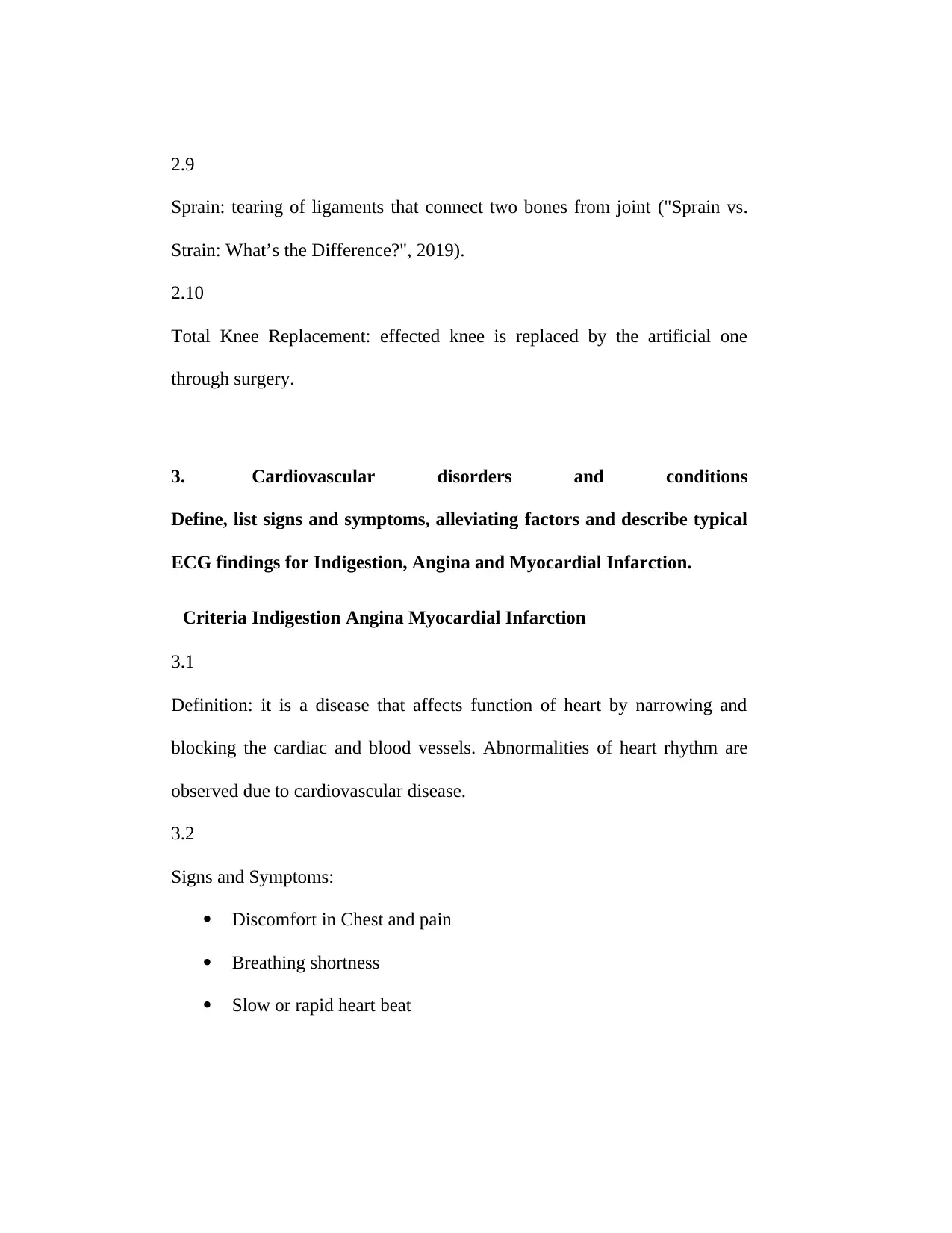
2.9
Sprain: tearing of ligaments that connect two bones from joint ("Sprain vs.
Strain: What’s the Difference?", 2019).
2.10
Total Knee Replacement: effected knee is replaced by the artificial one
through surgery.
3. Cardiovascular disorders and conditions
Define, list signs and symptoms, alleviating factors and describe typical
ECG findings for Indigestion, Angina and Myocardial Infarction.
Criteria Indigestion Angina Myocardial Infarction
3.1
Definition: it is a disease that affects function of heart by narrowing and
blocking the cardiac and blood vessels. Abnormalities of heart rhythm are
observed due to cardiovascular disease.
3.2
Signs and Symptoms:
Discomfort in Chest and pain
Breathing shortness
Slow or rapid heart beat
Sprain: tearing of ligaments that connect two bones from joint ("Sprain vs.
Strain: What’s the Difference?", 2019).
2.10
Total Knee Replacement: effected knee is replaced by the artificial one
through surgery.
3. Cardiovascular disorders and conditions
Define, list signs and symptoms, alleviating factors and describe typical
ECG findings for Indigestion, Angina and Myocardial Infarction.
Criteria Indigestion Angina Myocardial Infarction
3.1
Definition: it is a disease that affects function of heart by narrowing and
blocking the cardiac and blood vessels. Abnormalities of heart rhythm are
observed due to cardiovascular disease.
3.2
Signs and Symptoms:
Discomfort in Chest and pain
Breathing shortness
Slow or rapid heart beat
Paraphrase This Document
Need a fresh take? Get an instant paraphrase of this document with our AI Paraphraser
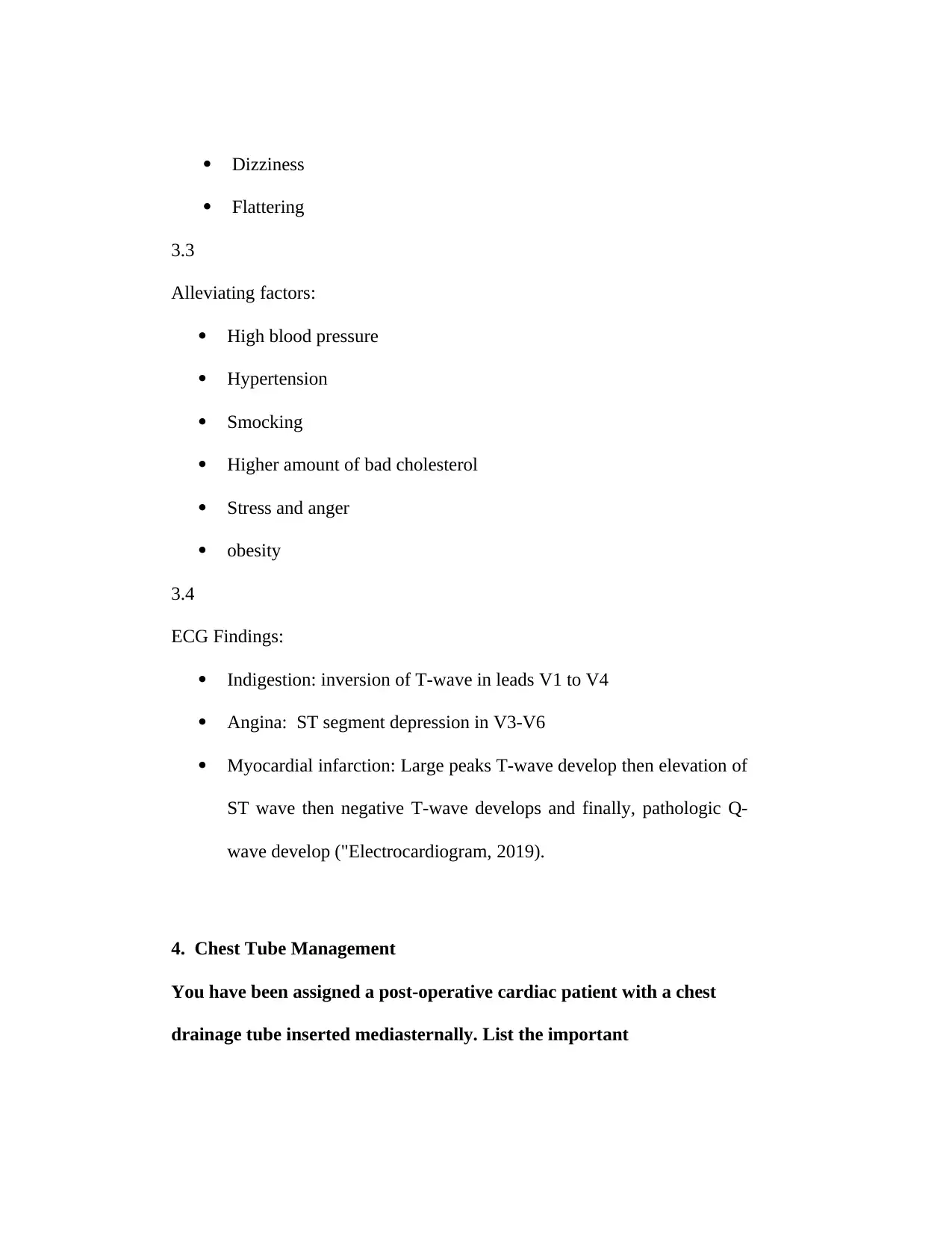
Dizziness
Flattering
3.3
Alleviating factors:
High blood pressure
Hypertension
Smocking
Higher amount of bad cholesterol
Stress and anger
obesity
3.4
ECG Findings:
Indigestion: inversion of T-wave in leads V1 to V4
Angina: ST segment depression in V3-V6
Myocardial infarction: Large peaks T-wave develop then elevation of
ST wave then negative T-wave develops and finally, pathologic Q-
wave develop ("Electrocardiogram, 2019).
4. Chest Tube Management
You have been assigned a post-operative cardiac patient with a chest
drainage tube inserted mediasternally. List the important
Flattering
3.3
Alleviating factors:
High blood pressure
Hypertension
Smocking
Higher amount of bad cholesterol
Stress and anger
obesity
3.4
ECG Findings:
Indigestion: inversion of T-wave in leads V1 to V4
Angina: ST segment depression in V3-V6
Myocardial infarction: Large peaks T-wave develop then elevation of
ST wave then negative T-wave develops and finally, pathologic Q-
wave develop ("Electrocardiogram, 2019).
4. Chest Tube Management
You have been assigned a post-operative cardiac patient with a chest
drainage tube inserted mediasternally. List the important
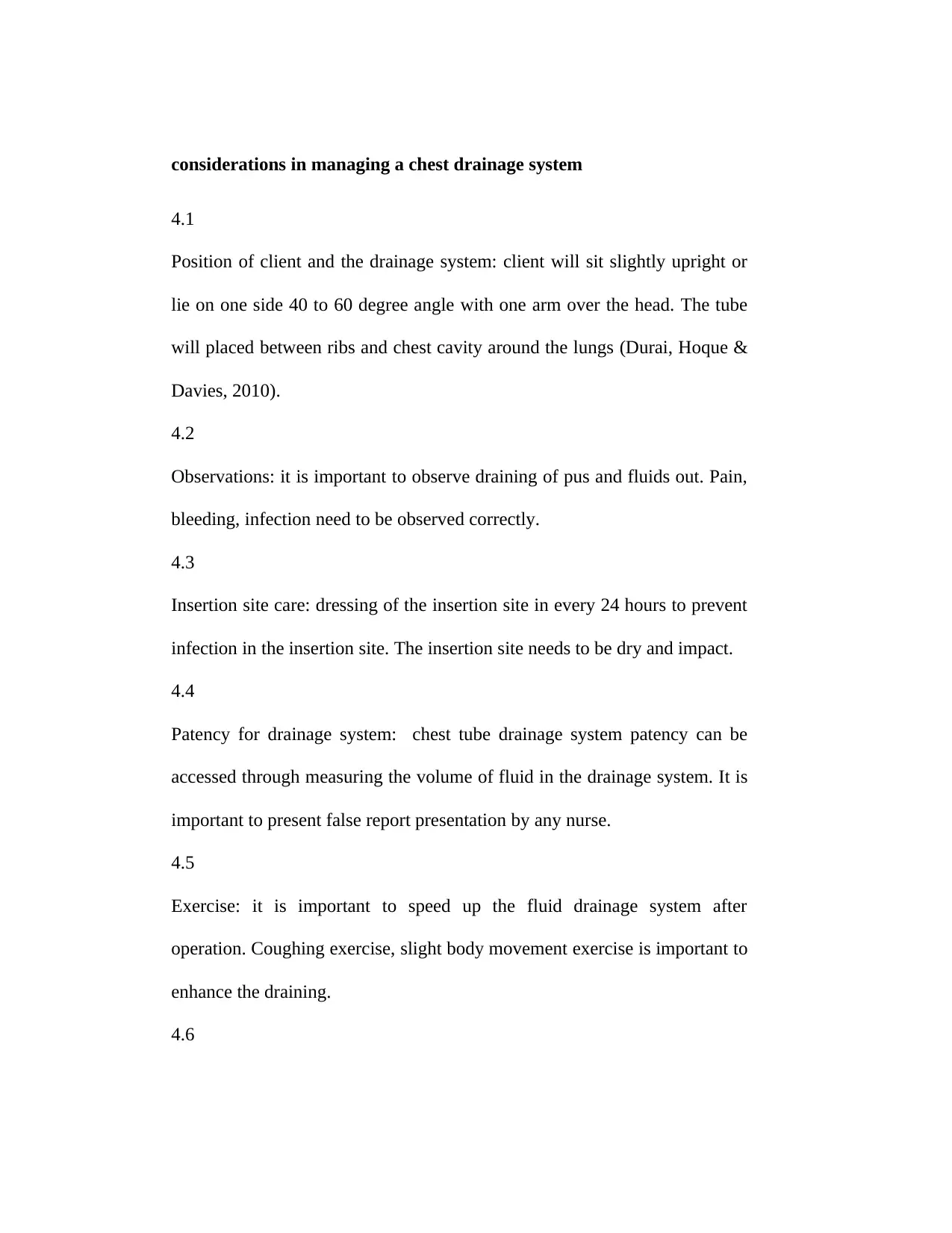
considerations in managing a chest drainage system
4.1
Position of client and the drainage system: client will sit slightly upright or
lie on one side 40 to 60 degree angle with one arm over the head. The tube
will placed between ribs and chest cavity around the lungs (Durai, Hoque &
Davies, 2010).
4.2
Observations: it is important to observe draining of pus and fluids out. Pain,
bleeding, infection need to be observed correctly.
4.3
Insertion site care: dressing of the insertion site in every 24 hours to prevent
infection in the insertion site. The insertion site needs to be dry and impact.
4.4
Patency for drainage system: chest tube drainage system patency can be
accessed through measuring the volume of fluid in the drainage system. It is
important to present false report presentation by any nurse.
4.5
Exercise: it is important to speed up the fluid drainage system after
operation. Coughing exercise, slight body movement exercise is important to
enhance the draining.
4.6
4.1
Position of client and the drainage system: client will sit slightly upright or
lie on one side 40 to 60 degree angle with one arm over the head. The tube
will placed between ribs and chest cavity around the lungs (Durai, Hoque &
Davies, 2010).
4.2
Observations: it is important to observe draining of pus and fluids out. Pain,
bleeding, infection need to be observed correctly.
4.3
Insertion site care: dressing of the insertion site in every 24 hours to prevent
infection in the insertion site. The insertion site needs to be dry and impact.
4.4
Patency for drainage system: chest tube drainage system patency can be
accessed through measuring the volume of fluid in the drainage system. It is
important to present false report presentation by any nurse.
4.5
Exercise: it is important to speed up the fluid drainage system after
operation. Coughing exercise, slight body movement exercise is important to
enhance the draining.
4.6
⊘ This is a preview!⊘
Do you want full access?
Subscribe today to unlock all pages.

Trusted by 1+ million students worldwide
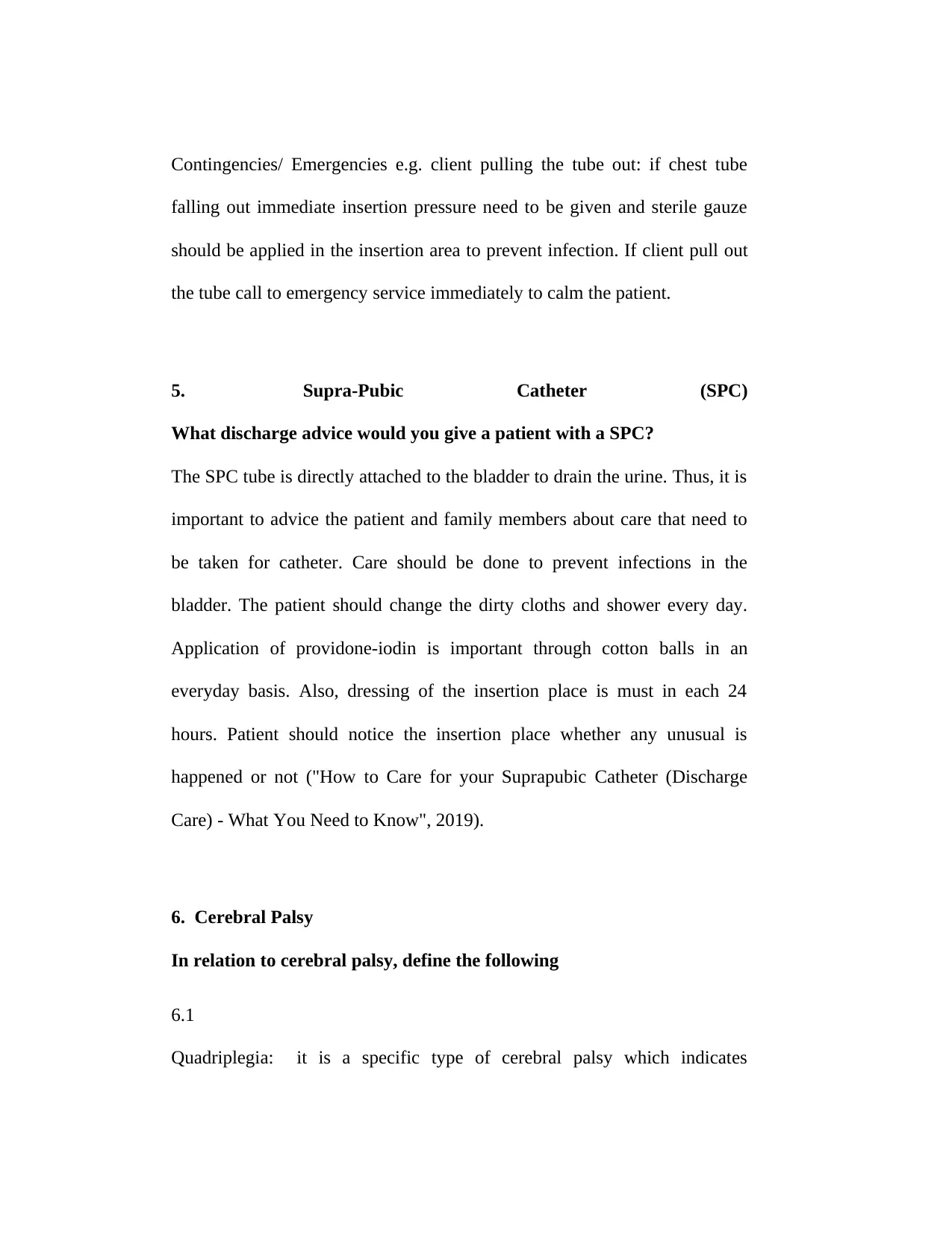
Contingencies/ Emergencies e.g. client pulling the tube out: if chest tube
falling out immediate insertion pressure need to be given and sterile gauze
should be applied in the insertion area to prevent infection. If client pull out
the tube call to emergency service immediately to calm the patient.
5. Supra-Pubic Catheter (SPC)
What discharge advice would you give a patient with a SPC?
The SPC tube is directly attached to the bladder to drain the urine. Thus, it is
important to advice the patient and family members about care that need to
be taken for catheter. Care should be done to prevent infections in the
bladder. The patient should change the dirty cloths and shower every day.
Application of providone-iodin is important through cotton balls in an
everyday basis. Also, dressing of the insertion place is must in each 24
hours. Patient should notice the insertion place whether any unusual is
happened or not ("How to Care for your Suprapubic Catheter (Discharge
Care) - What You Need to Know", 2019).
6. Cerebral Palsy
In relation to cerebral palsy, define the following
6.1
Quadriplegia: it is a specific type of cerebral palsy which indicates
falling out immediate insertion pressure need to be given and sterile gauze
should be applied in the insertion area to prevent infection. If client pull out
the tube call to emergency service immediately to calm the patient.
5. Supra-Pubic Catheter (SPC)
What discharge advice would you give a patient with a SPC?
The SPC tube is directly attached to the bladder to drain the urine. Thus, it is
important to advice the patient and family members about care that need to
be taken for catheter. Care should be done to prevent infections in the
bladder. The patient should change the dirty cloths and shower every day.
Application of providone-iodin is important through cotton balls in an
everyday basis. Also, dressing of the insertion place is must in each 24
hours. Patient should notice the insertion place whether any unusual is
happened or not ("How to Care for your Suprapubic Catheter (Discharge
Care) - What You Need to Know", 2019).
6. Cerebral Palsy
In relation to cerebral palsy, define the following
6.1
Quadriplegia: it is a specific type of cerebral palsy which indicates
Paraphrase This Document
Need a fresh take? Get an instant paraphrase of this document with our AI Paraphraser
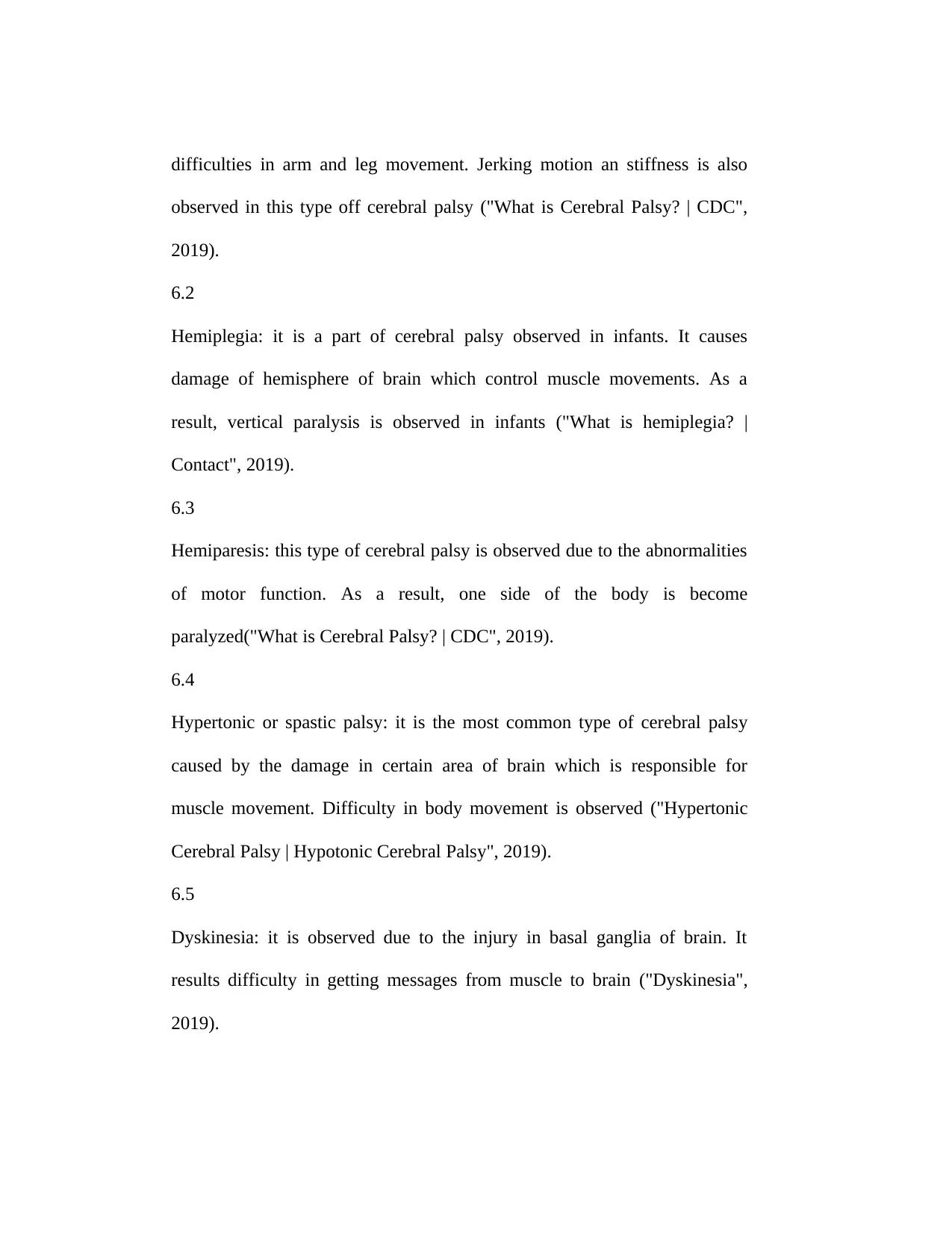
difficulties in arm and leg movement. Jerking motion an stiffness is also
observed in this type off cerebral palsy ("What is Cerebral Palsy? | CDC",
2019).
6.2
Hemiplegia: it is a part of cerebral palsy observed in infants. It causes
damage of hemisphere of brain which control muscle movements. As a
result, vertical paralysis is observed in infants ("What is hemiplegia? |
Contact", 2019).
6.3
Hemiparesis: this type of cerebral palsy is observed due to the abnormalities
of motor function. As a result, one side of the body is become
paralyzed("What is Cerebral Palsy? | CDC", 2019).
6.4
Hypertonic or spastic palsy: it is the most common type of cerebral palsy
caused by the damage in certain area of brain which is responsible for
muscle movement. Difficulty in body movement is observed ("Hypertonic
Cerebral Palsy | Hypotonic Cerebral Palsy", 2019).
6.5
Dyskinesia: it is observed due to the injury in basal ganglia of brain. It
results difficulty in getting messages from muscle to brain ("Dyskinesia",
2019).
observed in this type off cerebral palsy ("What is Cerebral Palsy? | CDC",
2019).
6.2
Hemiplegia: it is a part of cerebral palsy observed in infants. It causes
damage of hemisphere of brain which control muscle movements. As a
result, vertical paralysis is observed in infants ("What is hemiplegia? |
Contact", 2019).
6.3
Hemiparesis: this type of cerebral palsy is observed due to the abnormalities
of motor function. As a result, one side of the body is become
paralyzed("What is Cerebral Palsy? | CDC", 2019).
6.4
Hypertonic or spastic palsy: it is the most common type of cerebral palsy
caused by the damage in certain area of brain which is responsible for
muscle movement. Difficulty in body movement is observed ("Hypertonic
Cerebral Palsy | Hypotonic Cerebral Palsy", 2019).
6.5
Dyskinesia: it is observed due to the injury in basal ganglia of brain. It
results difficulty in getting messages from muscle to brain ("Dyskinesia",
2019).
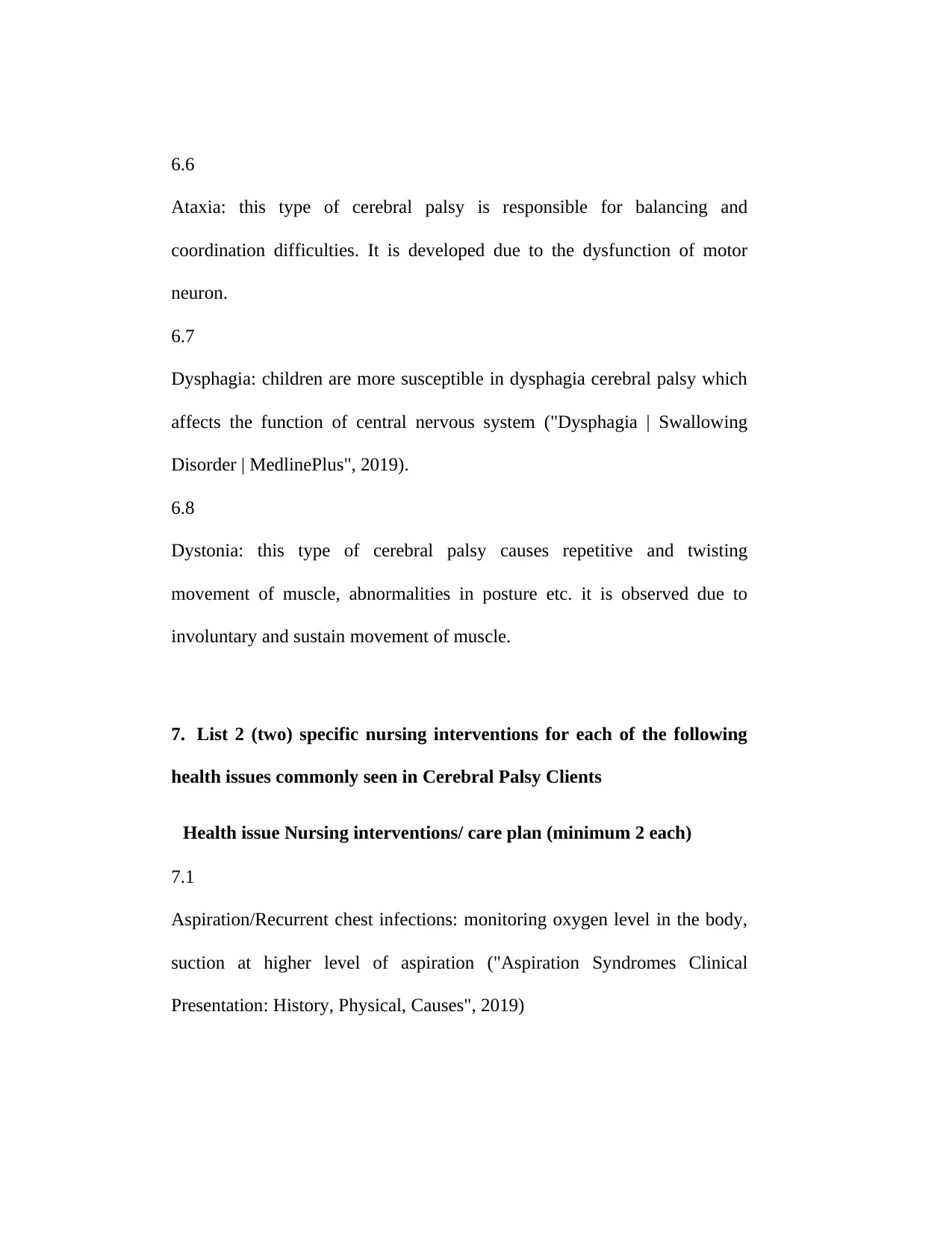
6.6
Ataxia: this type of cerebral palsy is responsible for balancing and
coordination difficulties. It is developed due to the dysfunction of motor
neuron.
6.7
Dysphagia: children are more susceptible in dysphagia cerebral palsy which
affects the function of central nervous system ("Dysphagia | Swallowing
Disorder | MedlinePlus", 2019).
6.8
Dystonia: this type of cerebral palsy causes repetitive and twisting
movement of muscle, abnormalities in posture etc. it is observed due to
involuntary and sustain movement of muscle.
7. List 2 (two) specific nursing interventions for each of the following
health issues commonly seen in Cerebral Palsy Clients
Health issue Nursing interventions/ care plan (minimum 2 each)
7.1
Aspiration/Recurrent chest infections: monitoring oxygen level in the body,
suction at higher level of aspiration ("Aspiration Syndromes Clinical
Presentation: History, Physical, Causes", 2019)
Ataxia: this type of cerebral palsy is responsible for balancing and
coordination difficulties. It is developed due to the dysfunction of motor
neuron.
6.7
Dysphagia: children are more susceptible in dysphagia cerebral palsy which
affects the function of central nervous system ("Dysphagia | Swallowing
Disorder | MedlinePlus", 2019).
6.8
Dystonia: this type of cerebral palsy causes repetitive and twisting
movement of muscle, abnormalities in posture etc. it is observed due to
involuntary and sustain movement of muscle.
7. List 2 (two) specific nursing interventions for each of the following
health issues commonly seen in Cerebral Palsy Clients
Health issue Nursing interventions/ care plan (minimum 2 each)
7.1
Aspiration/Recurrent chest infections: monitoring oxygen level in the body,
suction at higher level of aspiration ("Aspiration Syndromes Clinical
Presentation: History, Physical, Causes", 2019)
⊘ This is a preview!⊘
Do you want full access?
Subscribe today to unlock all pages.

Trusted by 1+ million students worldwide
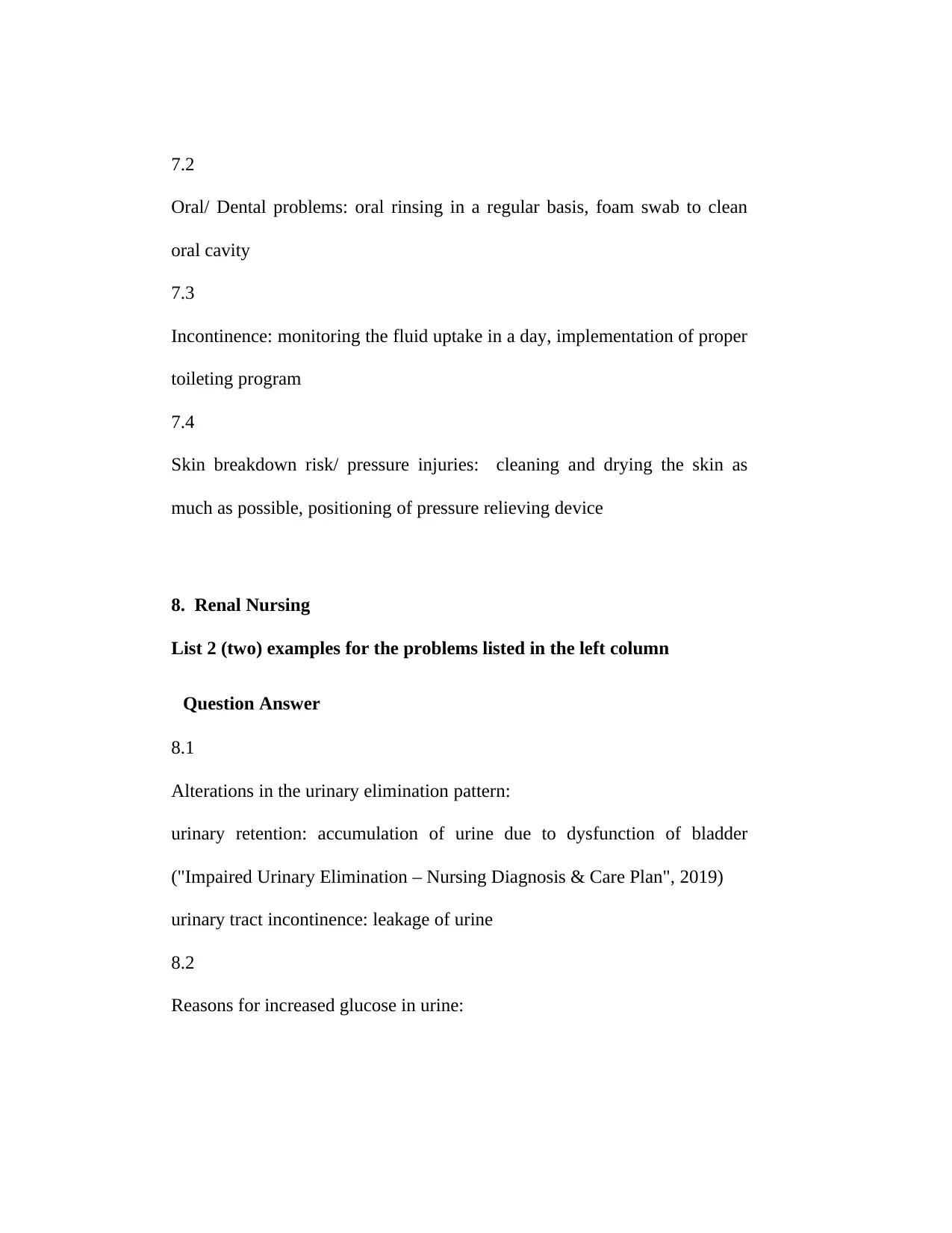
7.2
Oral/ Dental problems: oral rinsing in a regular basis, foam swab to clean
oral cavity
7.3
Incontinence: monitoring the fluid uptake in a day, implementation of proper
toileting program
7.4
Skin breakdown risk/ pressure injuries: cleaning and drying the skin as
much as possible, positioning of pressure relieving device
8. Renal Nursing
List 2 (two) examples for the problems listed in the left column
Question Answer
8.1
Alterations in the urinary elimination pattern:
urinary retention: accumulation of urine due to dysfunction of bladder
("Impaired Urinary Elimination – Nursing Diagnosis & Care Plan", 2019)
urinary tract incontinence: leakage of urine
8.2
Reasons for increased glucose in urine:
Oral/ Dental problems: oral rinsing in a regular basis, foam swab to clean
oral cavity
7.3
Incontinence: monitoring the fluid uptake in a day, implementation of proper
toileting program
7.4
Skin breakdown risk/ pressure injuries: cleaning and drying the skin as
much as possible, positioning of pressure relieving device
8. Renal Nursing
List 2 (two) examples for the problems listed in the left column
Question Answer
8.1
Alterations in the urinary elimination pattern:
urinary retention: accumulation of urine due to dysfunction of bladder
("Impaired Urinary Elimination – Nursing Diagnosis & Care Plan", 2019)
urinary tract incontinence: leakage of urine
8.2
Reasons for increased glucose in urine:
Paraphrase This Document
Need a fresh take? Get an instant paraphrase of this document with our AI Paraphraser
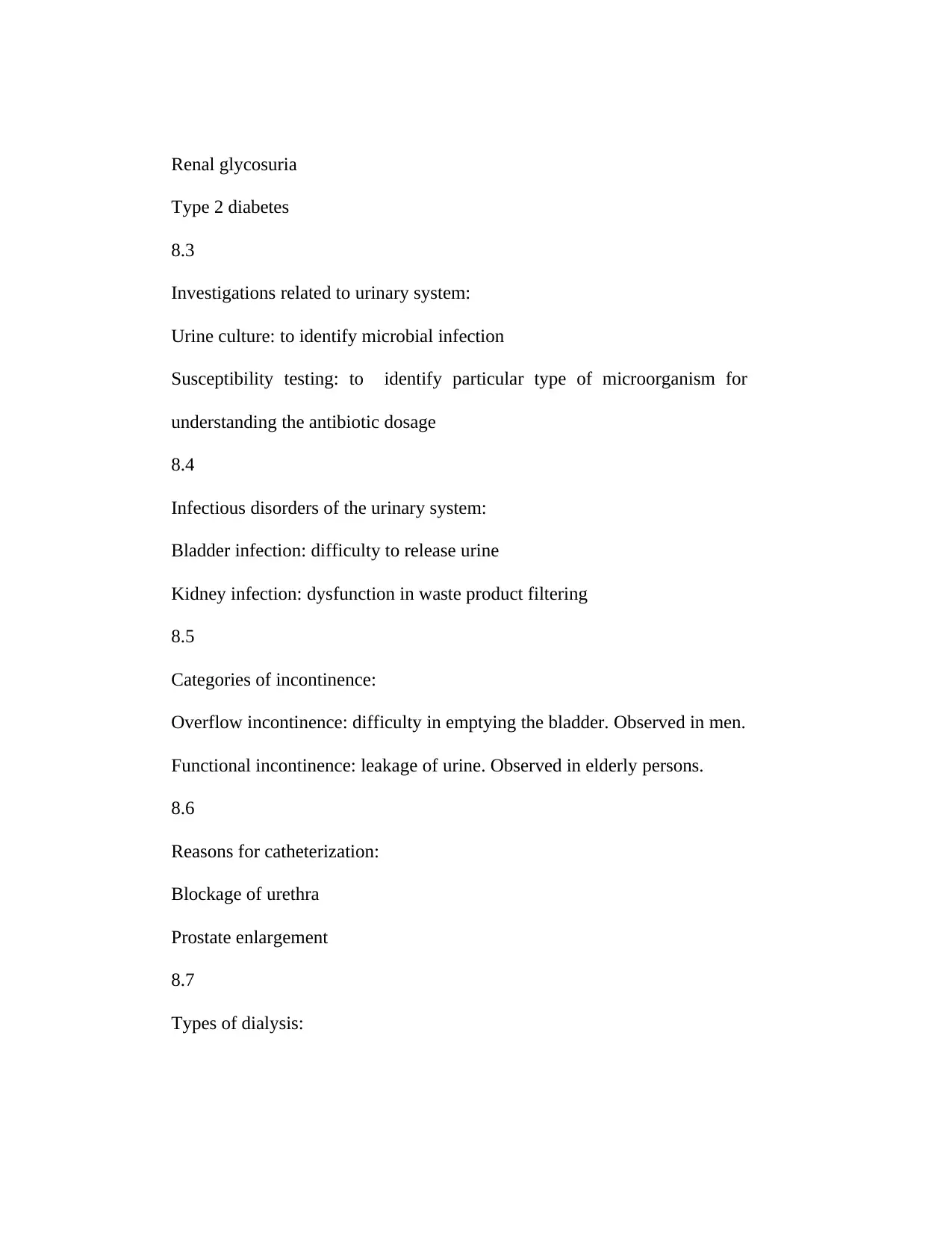
Renal glycosuria
Type 2 diabetes
8.3
Investigations related to urinary system:
Urine culture: to identify microbial infection
Susceptibility testing: to identify particular type of microorganism for
understanding the antibiotic dosage
8.4
Infectious disorders of the urinary system:
Bladder infection: difficulty to release urine
Kidney infection: dysfunction in waste product filtering
8.5
Categories of incontinence:
Overflow incontinence: difficulty in emptying the bladder. Observed in men.
Functional incontinence: leakage of urine. Observed in elderly persons.
8.6
Reasons for catheterization:
Blockage of urethra
Prostate enlargement
8.7
Types of dialysis:
Type 2 diabetes
8.3
Investigations related to urinary system:
Urine culture: to identify microbial infection
Susceptibility testing: to identify particular type of microorganism for
understanding the antibiotic dosage
8.4
Infectious disorders of the urinary system:
Bladder infection: difficulty to release urine
Kidney infection: dysfunction in waste product filtering
8.5
Categories of incontinence:
Overflow incontinence: difficulty in emptying the bladder. Observed in men.
Functional incontinence: leakage of urine. Observed in elderly persons.
8.6
Reasons for catheterization:
Blockage of urethra
Prostate enlargement
8.7
Types of dialysis:
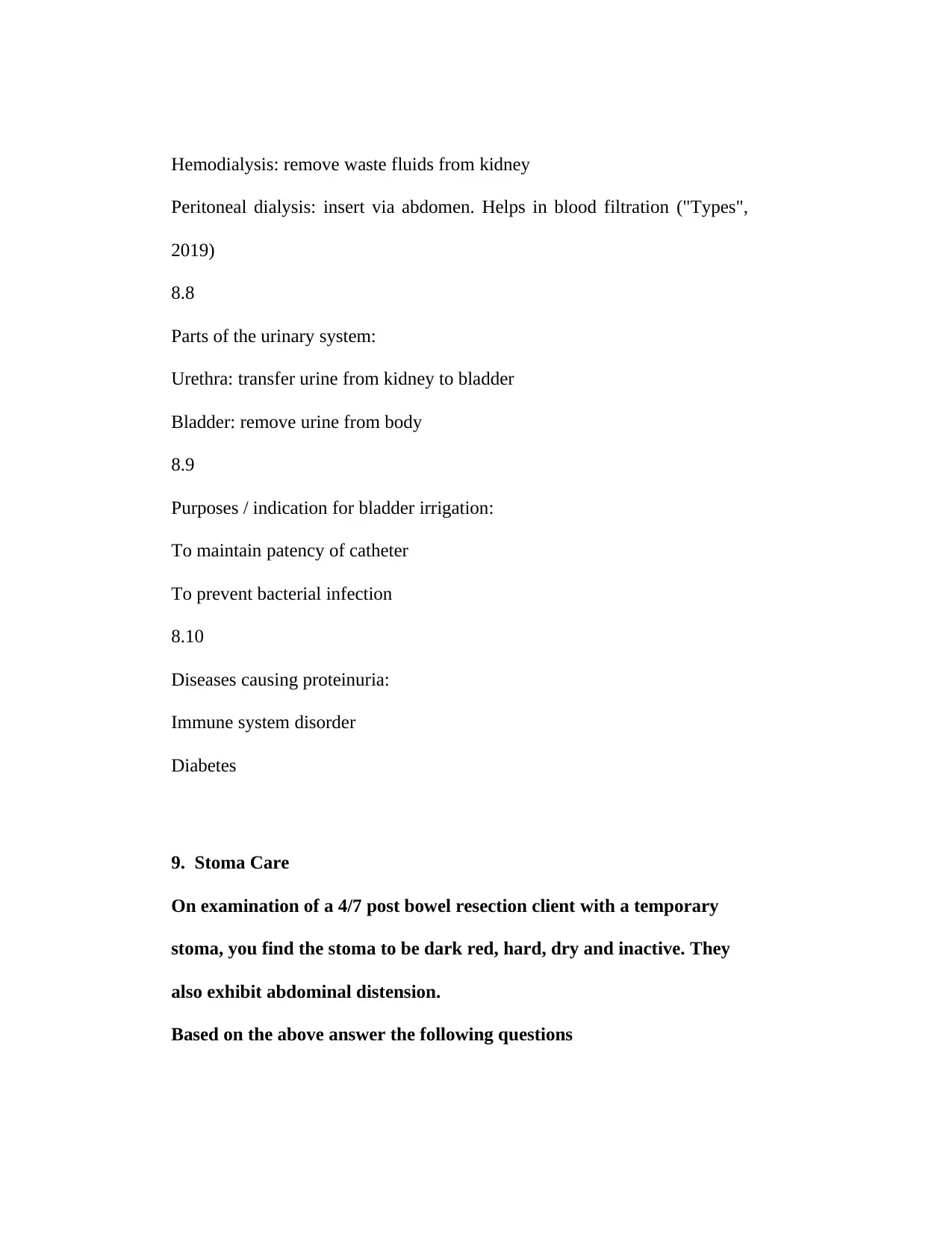
Hemodialysis: remove waste fluids from kidney
Peritoneal dialysis: insert via abdomen. Helps in blood filtration ("Types",
2019)
8.8
Parts of the urinary system:
Urethra: transfer urine from kidney to bladder
Bladder: remove urine from body
8.9
Purposes / indication for bladder irrigation:
To maintain patency of catheter
To prevent bacterial infection
8.10
Diseases causing proteinuria:
Immune system disorder
Diabetes
9. Stoma Care
On examination of a 4/7 post bowel resection client with a temporary
stoma, you find the stoma to be dark red, hard, dry and inactive. They
also exhibit abdominal distension.
Based on the above answer the following questions
Peritoneal dialysis: insert via abdomen. Helps in blood filtration ("Types",
2019)
8.8
Parts of the urinary system:
Urethra: transfer urine from kidney to bladder
Bladder: remove urine from body
8.9
Purposes / indication for bladder irrigation:
To maintain patency of catheter
To prevent bacterial infection
8.10
Diseases causing proteinuria:
Immune system disorder
Diabetes
9. Stoma Care
On examination of a 4/7 post bowel resection client with a temporary
stoma, you find the stoma to be dark red, hard, dry and inactive. They
also exhibit abdominal distension.
Based on the above answer the following questions
⊘ This is a preview!⊘
Do you want full access?
Subscribe today to unlock all pages.

Trusted by 1+ million students worldwide
1 out of 33
Your All-in-One AI-Powered Toolkit for Academic Success.
+13062052269
info@desklib.com
Available 24*7 on WhatsApp / Email
![[object Object]](/_next/static/media/star-bottom.7253800d.svg)
Unlock your academic potential
Copyright © 2020–2025 A2Z Services. All Rights Reserved. Developed and managed by ZUCOL.